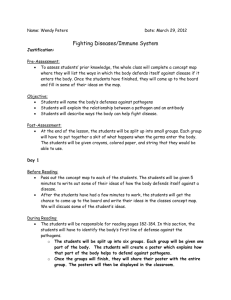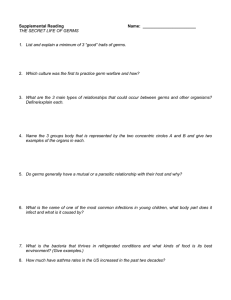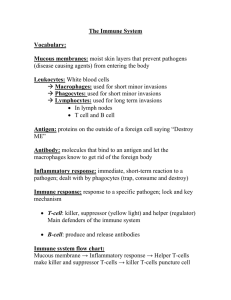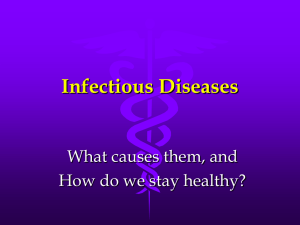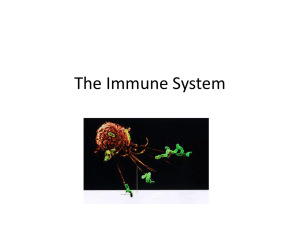Written by Sara LeBien A story for children with primary
advertisement
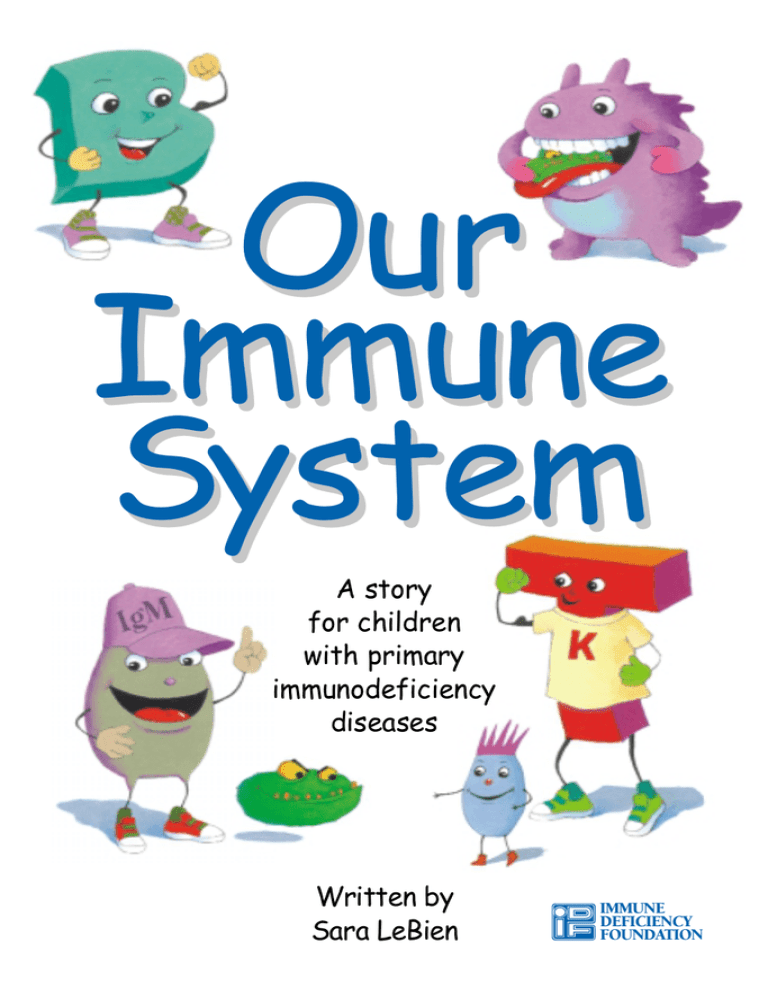
Our Immune System A story for children with primary immunodeficiency diseases Written by Sara LeBien IMMUNE DEFICIENCY FOUNDATION A note from the author The purpose of this book is to help young children who are immune deficient to better understand their immune system. What is a “B-cell,” a “T-cell,” an “immunoglobulin” or “IgG”? They hear doctors use these words, but what do they mean? With cheerful illustrations, Our Immune System explains how a normal immune system works and what treatments may be necessary when the system is deficient. In this second edition, a description of a new treatment has been included. I hope this book will enable these children and their families to explore together the immune system, and that it will help alleviate any confusion or fears they may have. Sara LeBien This book contains general medical information which cannot be applied safely to any individual case. Medical knowledge and practice can change rapidly. Therefore, this book should not be used as a substitute for professional medical advice. SECOND EDITION COPYRIGHT 1990, 2007 IMMUNE DEFICIENCY FOUNDATION Copyright 2007 by Immune Deficiency Foundation, USA. Readers may redistribute this article to other individuals for non-commercial use, provided that the text, html codes, and this notice remain intact and unaltered in any way. Our Immune System may not be resold, reprinted or redistributed for compensation of any kind without prior written permission from Immune Deficiency Foundation. If you have any questions about permission, please contact: Immune Deficiency Foundation, 40 West Chesapeake Avenue, Suite 308, Towson, MD 21204, USA; or by telephone at 1-800-296-4433. IMMUNE DEFICIENCY FOUNDATION We have things inside our bodies that protect us from being sick. These things are found in our immune system. 1 One kind of protector is the B-Cell. B-Cells make immunoglobulins (im-mu-no-glob-u-lins), also called antibodies (an-ti-bod-ies) or Igs. Each has a certain job THE 3 MOST IMPORTANT IMMUNOGLOBULINS to do to keep us well. They are like guards. They guard us from getting sick. 2 Their job is to kill germs, such as viruses, fungi, and bacteria that get into our bodies and make us sick. n Come o dy! everybo sy, t bu Let’s ge ot we’ve g ! do work to IgM protects our blood and other things inside us. 3 IgG travels in our blood to get to the germs. IgA protects the places where we have saliva, tears, and mucus like our mouth, nose, lungs, and intestines. 4 Sometimes the Igs help each other gang up on germs. Let’s get him! I’ll help you! I will come, too! Here is a germ we need to get!! It’s all over, Germie! Gotcha! 5 Another kind of protector is the T-cell. T-cells are very important, too. They are in our blood. But they also go to other places inside our body. 6 There are 3 kinds of T-cellsKiller T-cells, Helper T-cells and Regulatory T-cells Killer T-cells kill germs. Got Ya! 7 CALLING ALL ! WE KILLER T-CELLS YOU! NEED MORE OF Helper T-cells call in more Killer T-cells to kill germs and tell the B-cells when to make antibodies. S AY, YOU B-CELL OK SE PRODUCE THO ! IG ANTIBODIES 8 The Regulator T-cell tells the B-cells and other T-cells when the body is better and they can stop making antibodies. Okay B-cells you can stop now! 9 Another protector is the Phagocyte (Phag-o-cyte). Phagocytes kill germs by eating them! They also send signals to other Phagocytes to help. Calling all Phagocytes! Calling all Phagocytes! Help! Help! Help! 10 The last protector is the Complement (Com-ple-ment). The Complement is made of many pieces working together to protect us from infection. The Complement system works with the Igs and Phagocytes to help get rid of germs faster. 11 So there are antibodies (immunoglobulins or Igs) made in B-cells, I make the cells go into action! I tell the B-cells when to stop! I tell the Killer T-cells to attack germs! I tell the B-cells when to make antibodies. 3 kinds of T-cells, I kill germs! 12 Phagocytes and Complement. 13 But some of us don’t have all of our protectors, or we have them but they do not work. Sometimes germs get into our bodies through our eyes, nose, mouth, lungs or blood. Ohhh... my throat hurts! We do not have all the protection we need to kill the germs. So the germs grow into many germs, 14 and we get sick. Maybe we feel very tired or have a fever, or have a sore throat, or have a bad cough, or our ears hurt, or our chest hurts, or our stomach hurts. The doctor calls it an infection (in-fec-tion). 15 Sometimes we have to go to the doctor. We may have to go to the hospital so the doctors and nurses can take care of us. 16 But, if we do not have enough IgG protectors there are ways to get more. We may get them from an infusion (in-fu-sion) or IV into a vein in our hand or arm. What is an IV? IV means into a vein. The nurse gets the antibodies (IgGs) into our vein. This is called an intravenous (in-tra-ven-ous) infusion or IVIG. 17 This is how IVIG is done. The nurse puts a little needle into our hand or our arm. It goes into our blue vein. Can you see your blue vein? If we sit still, it only hurts a little bit. The nurse puts a little piece of tape on the needle to hold it in place. A pump pumps the antibodies into our vein. 18 Some people get their infusion under the skin. This is called a subcutaneous (sub-cu-ta-ne-ous) infusion or SCIG. This is how SCIG is done. A few tiny needles are put under the skin on our belly or legs. If we sit still it only hurts a tiny bit. Little pieces of tape hold the tiny needles in place. A small pump pumps the antibodies under our skin. 19 The IgG antibodies run down, down, down inside the plastic tube into our vein or under our skin. The IgG antibodies get into our blood and go all through our body to protect us. When we get an intravenous infusion or subcutaneous infusion we can do quiet activities like read a book, play a game or watch TV. 20 Now the antibodies can go all through our body to protect us. Sometimes, we also need medicine to make the infection go away. It may be an injection, a pill or a liquid. This medicine is called an antibiotic (an-ti-bi-ot-ic). It kills germs, too. 21 Some people need glasses to help them see better. Some people need hearing aids to help them hear better. 22 We need IgGs and antibiotics to help us feel better. 23 Follow these Healthy Habits 1. Eat healthy foods 2. Get plenty of rest 3. Get regular exercise 4. Wash your hands: Before you eat After you use the rest room After being in a public place After playing with your pet After you cough or sneeze 5. Brush your teeth twice each day 6. Don’t share food or drinks with other people 7. Cover your cough or sneeze with a tissue 24 Important Words This list will help you understand some of the important words in this book. Antibiotics (an-ti-bi-ot-ics) special medicine that can help your body fight germs Antibodies (an-ti-bod-ies) also called immunoglobulins protect our bodies from germs B-Cells make immunoglobulins Complement (com-ple-ment) a group of proteins that work together, like a team, to fight germs Germ a tiny living thing that may make you sick Immunoglobulins (im-mu-no-glob-u-lins) also called antibodies or Igs IVIG immunoglobulin infused into a vein Intravenous (in-tra-ven-ous) into a vein Phagocyte (phag-o-cyte) identifies germs and gets rid of them by eating them SCIG immunoglobulin infused under the skin Subcutaneous (sub-cu-ta-ne-ous) under the skin T-Cells identify germs and tell the body how to fight them This publication was made possible by an unrestricted educational grant from IMMUNE DEFICIENCY FOUNDATION The National Patient Organization Dedicated to Advocacy, Education and Research for Primary Immunodeficiency Diseases 40 WEST CHESAPEAKE AVENUE • SUITE 308 • TOWSON, MD 21204 800.296.4433 • www.primaryimmune.org
